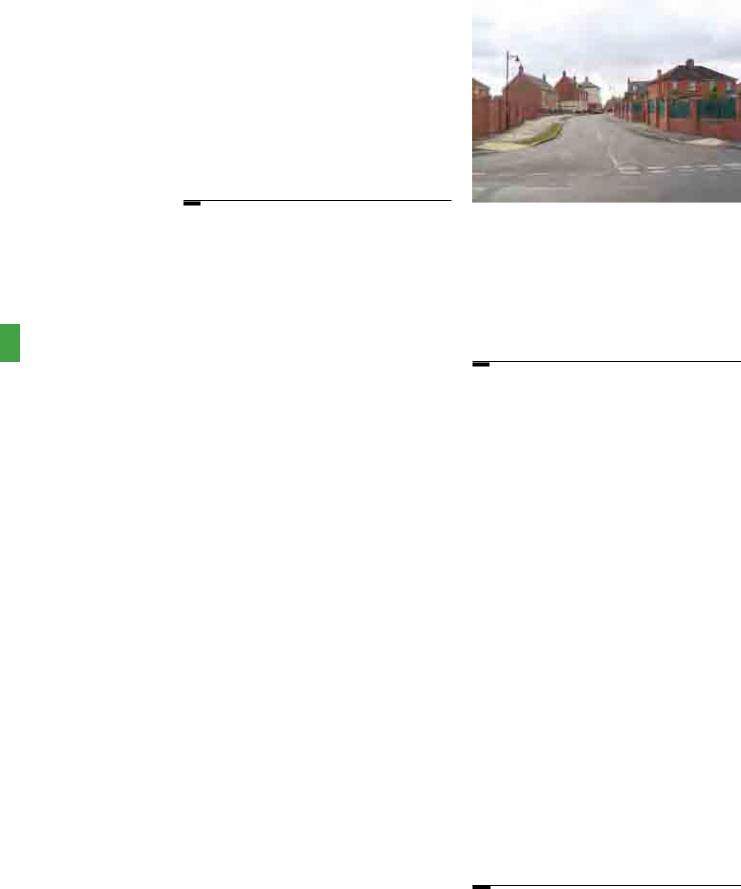

Preface
Manual for Streets (MfS) replaces Design Bulletin 32, first published in 1977, and its companion guide Places, Streets and Movement. It puts well-designed residential streets at the heart of sustainable communities.
For too long the focus has been on the movement function of residential streets. The result has often been places that are dominated by motor vehicles to the extent that they fail to make a positive contribution to the quality of life. MfS demonstrates the benefits that flow from good design and assigns a higher priority to pedestrians and cyclists, setting out an approach to residential streets that recognises their role in creating places that work for all members of the community. MfS refocuses on the place function of residential streets, giving clear guidance on how to achieve well-designed streets and spaces that serve the community in a range of ways.
MfS updates the link between planning policy and residential street design. It challenges some established working practices and standards that are failing to produce good-quality outcomes, and asks professionals to think differently about their role in creating successful neighbourhoods. It places particular emphasis on the importance of collaborative working and coordinated decision-making, as well as on the value of strong leadership and a clear vision of design quality at the local level.
Research carried out in the preparation of Manual for Streets indicated that many of the criteria routinely applied in street design are based on questionable or outdated practice. For example, it showed that, when long forward visibility is provided and generous carriageway width is specified, driving speeds tend to increase. This demonstrates that driver behaviour is not fixed; rather, it can be influenced by
the environment. MfS addresses these points, recommending revised key geometric design criteria to allow streets to be designed as places in their own right while still ensuring that road safety is maintained.
MfS is clear that uncoordinated decision-making can result in disconnected, bland places that fail to make a contribution to the creation
of thriving communities. It recommends that development teams are established to negotiate issues in the round and retain a focus on the creation of locally distinct, high-quality places. Where high levels of change are anticipated, designers and other stakeholders are encouraged to work together strategically from an early stage. MfS also recommends the use of tools such as masterplans and design codes.
Neighbourhoods where buildings, streets and spaces combine to create locally distinct places and which make a positive contribution to the life of local communities need to become more widespread. MfS provides a clear framework for the use of local systems and procedures; it also identifies the tools available to ensure that growth and change are planned for and managed in an integrated way. The aspirations of MfS – interdisciplinary working, strategic coordination and balanced decision making – will only become a reality if they are developed and applied at a local level. This is already happening in some places, and the results are promising – this document aims to make the adoption of such practice the norm.
MfS does not set out new policy or introduce new additional burdens on local authorities, highway authorities or developers. Rather
it presents guidance on how to do things differently within the existing policy, technical and legal framework.
Manual for Streets |
|


A
Context and process

1
Introduction
Countryside Properties

1Office of the Deputy Prime Minister (ODPM) (2005) Planning Policy Statement 1: Delivering Sustainable Development.
London: The Stationery Office (TSO).
2Communities and Local Government (2006)
Planning Policy Statement
3:Housing. London: TSO. 3 Welsh Assembly
Government (2002).
Planning Policy Wales.
Cardiff: National Assembly for Wales (NAfW). Chapter 2, Planning for Sustainability.
4 Commission for Architecture and the Built Environment (CABE) (2006) The Principles of Inclusive Design (They Include You). London: CABE. (Wales: See
also Welsh Assembly Government (2002).
Technical Advice Note 12: Design. Cardiff: NAfW. Chapter 5, Design Issues.)
Chapter aims
•Set out the aims of Manual for Streets.
•Explain the status of Manual for Streets and its relationship with local design standards and the Design Manual for Roads and Bridges.
•Promote greater collaboration between all those involved in the design, approval and adoption processes.
•Summarise key changes from previous guidance.
1.1Aims of the document
1.1.1There is a need to bring about a transformation in the quality of streets. This requires a fundamental culture change in the way streets are designed and adopted, including a more collaborative approach between the design professions and other stakeholders. People need to think creatively about their various roles in the process of delivering streets, breaking away from standardised, prescriptive, risk-averse methods to create high-quality places.
1.1.2Streets make up the greater part of the public realm. Better-designed streets therefore contribute significantly to the quality of the built environment and play a key role in the creation of sustainable, inclusive, mixed communities consistent with the policy objectives of Planning Policy Statement 1: Delivering Sustainable Development (PPS1)1, Planning Policy Statement 3: Housing (PPS3)2 and Planning Policy Wales
(PPW).3
1.1.3Manual for Streets (MfS) is expected
to be used predominantly for the design, construction, adoption and maintenance of new residential streets, but it is also applicable to existing residential streets subject to re-design. For new streets, MfS advocates a return to more traditional patterns which are easier to assimilate into existing built-up areas and which have been proven to stand the test of time in many ways.
1.1.4 Streets should not be designed just to accommodate the movement of motor vehicles. It is important that designers place a high priority
Countryside Properties
Figure 1.1 Streets should be attractive places that meet the needs of all users.
on meeting the needs of pedestrians, cyclists and public transport users, so that growth in these modes of travel is encouraged (Fig. 1.1).
1.1.5 MfS aims to assist in the creation of streets that:
•help to build and strengthen the communities they serve;
•meet the needs of all users, by embodying the principles of inclusive design (see box);
•form part of a well-connected network;
•are attractive and have their own distinctive identity;
•are cost-effective to construct and maintain; and
•are safe.
The principles of inclusive design
Inclusive design:4
•placespeopleattheheartofthedesignprocess;
•acknowledges diversity and difference;
•offers choice where a single solution cannot accommodate all users;
•provides for flexibility in use; and
•provides buildings and environments that are convenient and enjoyable to use for everyone.
1.1.6 MfS discourages the building of streets that are:
•primarily designed to meet the needs of motor traffic;
•bland and unattractive;
•unsafe and unwelcoming to pedestrians and cyclists;
•difficult to serve by public transport; and
•poorly designed and constructed (Fig. 1.2).
Manual for Streets |
11 |

1.1.7 For the purposes of this document, a street is defined as a highway that has important public realm functions beyond the movement of traffic. Most critically, streets should have a sense of place, which is mainly realised through local distinctiveness and sensitivity in design.They also provide direct access to the buildings and the spaces that line them. Most highways in built-up areas can therefore be considered as streets.
1.2Who the manual is for
1.2.1 MfS is directed to all those with a part to play in the planning, design, approval or adoption of new residential streets, and modifications to existing residential streets. This includes the following (in alphabetical order):
•Organisations:
–developers;
–disability and other user groups;
–emergency services;
–highway and traffic authorities;
–planning authorities;
–public transport providers;
–utility and drainage companies; and
–waste collection authorities.
•Professions:
–access/accessibility officers;
–arboriculturists;
–architects;
–drainage engineers;
–highway/traffic engineers;
–landscape architects;
–local authority risk managers;
–police architectural liaison officers and crime prevention officers;
–road safety auditors;
–street lighting engineers;
–town planners;
–transport planners;
–urban designers.
1.2.2These lists are not exhaustive and there are other groups with a stake in the design of streets. Local communities, elected members and civic groups, in particular, are encouraged to make use of this document.
1.2.3MfS covers a broad range of issues and it is recommended that practitioners read every section regardless of their specific area of interest. This will create a better understanding of the many and, in some cases, conflicting
Andrew Cameron, WSP
Figure 1.2 Streets should not be bland and unwelcoming.
priorities that can arise. A good design will represent a balance of views with any conflicts resolved through compromise and creativity.
1.3Promoting joint working
1.3.1In the past street design has been dominated by some stakeholders at the expense of others, often resulting in unimaginatively designed streets which tend to favour motorists over other users.
1.3.2MfS aims to address this by encouraging a more holistic approach to street design, while assigning a higher priority to the needs of pedestrians, cyclists and public transport. The intention is to create streets that encourage greater social interaction and enjoyment while still performing successfully as conduits for movement.
1.3.3It is important for the various parts of local government to work together when giving input to a development proposal. Developers may be faced with conflicting requirements if different parts of local government fail to coordinate their input. This can cause delay and a loss of design quality. This is particularly problematic when one section of a local authority – for example the highway adoption or maintenance engineers
– become involved late on in the process and require significant changes to the design. A collaborative process is required from the outset.
1.4DMRBandotherdesignstandards
1.4.1 The Department for Transport does not set design standards for highways – these are set by the relevant highway authority.
12 |
Manual for Streets |

5Highways Agency (1992)
Design Manual for Roads and Bridges. London: TSO.
6ODPM and Department for Transport (2003) Better Streets, Better Places: Delivering Sustainable Residential Environments;
PPG3 and Highway Adoption
London: TSO.
1.4.2The Secretary of State for Transport is the highway authority for trunk roads in England and acts through the Highways Agency (HA). In Wales the Welsh Assembly Government is the highway authority for trunk roads. The standard for trunk roads is the Design Manual for Roads and Bridges (DMRB).5
1.4.3Some trunk roads could be described as ‘streets’ within the definition given in MfS, but their strategic nature means that traffic movement is their primary function. MfS does not apply to trunk roads.
1.4.4The DMRB is not an appropriate design standard for most streets, particularly those in lightly-trafficked residential and mixed-use areas.
1.4.5Although MfS provides guidance on technical matters, local standards and design guidance are important tools for designing in accordance with the local context. Many
local highway authorities have developed their own standards and guidance. Some of these documents, particularly those published in recent years, have addressed issues of placemaking and urban design, but most have not. It is therefore strongly recommended that local authorities review their standards and guidance to embrace the principles of MfS. Local standards and guidance should focus on creating and improving local distinctiveness through the appropriate choice of layouts and materials while adhering to the overall guidance given in MfS.
1.5Development of Manual for Streets
1.5.1The preparation of MfS was recommended in Better Streets, Better Places,6 which advised on how to overcome barriers to the creation of better quality streets.
1.5.2MfS has been produced as a collaborative effort involving a wide range of key stakeholders with an interest in street design. It has been developed by a multi-disciplinary team of highway engineers, urban designers, planners and researchers. The recommendations contained herein are based on a combination of:
• primary research;
• a review of existing research;
• case studies;
•existing good practice guidance; and
•consultation with stakeholders and practitioners.
1.5.1 During its preparation, efforts have been made to ensure that MfS represents a broad consensus and that it is widely accepted as good practice.
1.6Changes in approach
1.6.1 The main changes in the approach to street design that MfS recommends are
as follows:
•applying a user hierarchy to the design process with pedestrians at the top;
•emphasising a collaborative approach to the delivery of streets;
•recognising the importance of the community function of streets as spaces for social interaction;
•promoting an inclusive environment that recognises the needs of people of all ages and abilities;
•reflecting and supporting pedestrian desire lines in networks and detailed designs;
•developing masterplans and preparing design codes that implement them for larger-scale developments, and using design and access statements for all scales of development;
•creating networks of streets that provide permeability and connectivity to main destinations and a choice of routes;
•moving away from hierarchies of standard road types based on traffic flows and/or the number of buildings served;
•developing street character types on a location-specific basis with reference to both the place and movement functions for each street;
•encouraging innovation with a flexible approach to street layouts and the use of locally distinctive, durable and maintainable materials and street furniture;
•using quality audit systems that demonstrate how designs will meet key objectives for the local environment;
•designing to keep vehicle speeds at or below 20 mph on residential streets unless there are overriding reasons for accepting higher speeds; and
•using the minimum of highway design features necessary to make the streets work properly.
Manual for Streets |
13 |
